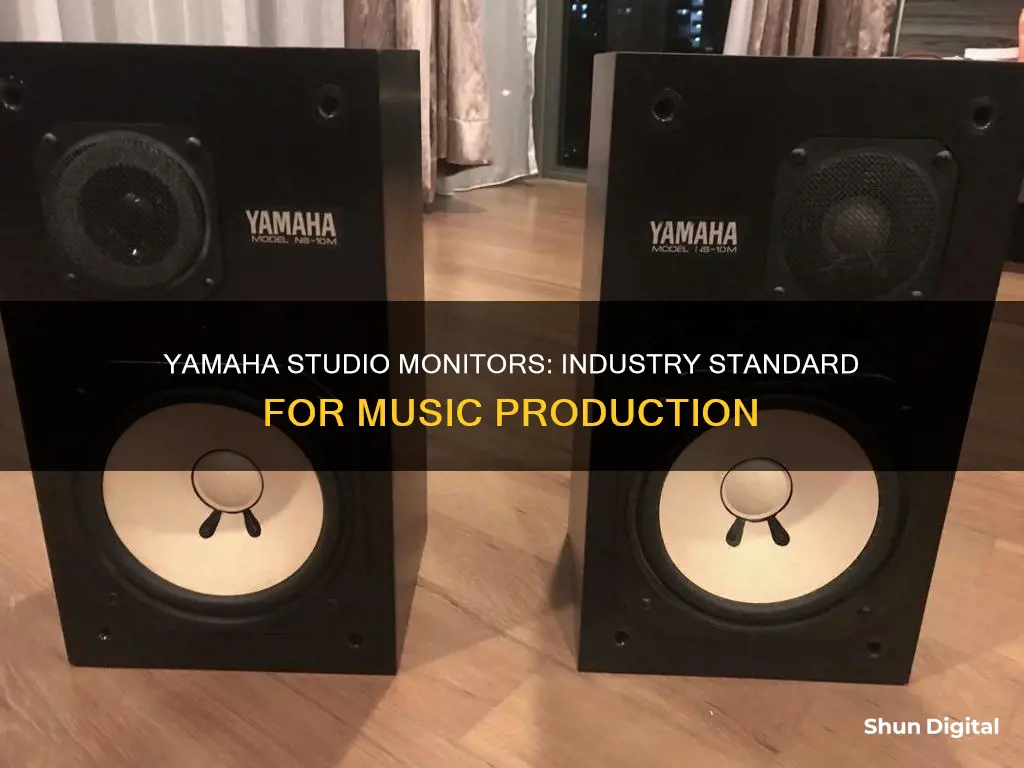
Yamaha's studio monitors have become a genuine industry standard, renowned for their accuracy and signature sound. The Yamaha HS Series, in particular, has emerged as the speaker choice in countless studios since its launch in 2013, offering three options to cater to diverse studio needs and room dimensions. The iconic white woofer and signature sound of Yamaha's nearfield reference monitors set them apart, delivering tight and clear bass with an emphasis on honest and transparent sound reproduction. Unlike other studio monitors that may overly amplify bass frequencies, Yamaha's speakers provide an ideal sonic platform for mixing, ensuring that a mix that sounds good on them will sound good anywhere. With a focus on accuracy and high-quality sound, Yamaha's studio monitors are a trusted choice for engineers and producers alike.
What You'll Learn

Yamaha studio monitors are designed for accuracy
Yamaha's studio monitors are designed with accuracy as the top priority. The entire production process, from the meticulous selection of materials for their customised transducers to the rigorous testing of acoustic properties and enclosure design, is geared towards achieving precise, high-quality sound. The result is a sonic platform that delivers an honest representation of your recordings, enabling you to make informed decisions during the mixing process.
The iconic white woofer and signature sound of Yamaha's nearfield reference monitors have become an industry standard due to their accuracy. Unlike other studio monitors that may enhance bass or treble frequencies, Yamaha's HS Series speakers provide an unbiased, precise reference. This commitment to sonic purity ensures that your mixes will sound good not just on Yamaha monitors but on any playback system.
The Yamaha HS Series offers three options to suit different studio needs and room dimensions: the HS5, HS7, and HS8. The HS5, with its 5-inch woofer driver, delivers 70 watts of power, making it perfect for small rooms and home mixing. The HS7 and HS8 offer more power, with 6.5-inch and 8-inch woofer units respectively, and are suitable for a majority of near-field studio setups. All speakers in the HS Series feature high-performance amplifiers designed to provide a flat frequency response, ensuring impressive performance regardless of the musical genre.
The Yamaha HS Series studio monitors also provide flexibility with their ROOM CONTROL feature, allowing you to adjust the low-end frequencies and compensate for unwanted bass resonances in different room setups. Additionally, the HIGH TRIM function lets you modify the level of top-end frequencies. Input-wise, the HS Series offers both XLR and TRS jack options, accommodating a wide range of input sources such as mixers, keyboards, and audio interfaces.
With their focus on accuracy and flexibility, Yamaha studio monitors are an industry-standard choice for professionals seeking an honest and reliable sonic platform for their mixing and monitoring needs.
Troubleshooting Guide: Identifying a Dead Monitor
You may want to see also

Yamaha's trademark sonic stamp and rigid design
Yamaha's studio monitors are renowned for their accuracy, which has been the industry standard since the 1970s. The iconic white woofer and signature sound of Yamaha's near-field reference monitors are designed to deliver the most honest and precise sound possible, providing an ideal sonic platform for mixing. This accuracy is achieved through meticulous material selection for their customised transducers and rigorous testing of acoustic properties and enclosure design.
The Yamaha HS5 series, in particular, is highly regarded for its ultra clarity and transparency, making it the perfect choice for mix engineers who want a true representation of their recordings. The HS5s are based on the old Yamaha NS10 studio monitors, which were chosen not for their pleasing sound but for their ability to reveal flaws in a mix. The philosophy behind the HS5s is that if a mix sounds good on these monitors, it will sound good anywhere. This is achieved through a focus on accuracy rather than added bass or treble frequencies, which may be more flattering but less true to the original recording.
The Yamaha HS Series carries on the tradition of being one of the most trusted speakers for near-field monitoring applications, lauded for their signature sound and superior accuracy. The speaker engineering team at Yamaha has optimised every aspect of these monitors, from the meticulous selection of materials to state-of-the-art sound technologies, ensuring they meet the demands of even the most discerning ear.
In addition to accuracy, Yamaha's studio monitors also offer a wide range of input sources, accommodating mixers, keyboards, and audio interfaces via XLR or TRS phone jack inputs. The combination of accuracy, versatility, and rigorous attention to detail makes Yamaha's studio monitors a top choice for professional engineers who are serious about their mixes and demand precise, high-quality sound.
Monitoring Memory Usage: A Guide for iMac Users
You may want to see also

The Yamaha HS series has three options to choose from
All three options in the Yamaha HS series are designed to provide an honest and precise reference sound for mixing and monitoring applications. They are known for their accuracy and flat frequency response, ensuring that what you hear is a true representation of your recordings. The HS series is the result of Yamaha's speaker engineering team leveraging the company's expertise and state-of-the-art technology to optimize every aspect of these studio monitors.
The HS series studio monitors feature newly developed transducers that produce a smooth and consistent response across the entire bandwidth. The 1-inch dome tweeter expands the usable frequency range up to 30kHz, while the robust waveguide minimizes unwanted vibrations for smooth, high-resolution sound. The woofers in the HS series are also newly designed and ultra-responsive, with carefully selected magnets to reduce bass distortion and deliver a well-defined bottom end at all output levels.
In terms of connectivity, the Yamaha HS series studio monitors are flexible and can accommodate a wide range of input sources. They feature XLR and TRS phone jack inputs, allowing you to connect mixers, keyboards, and audio interfaces with ease. Additionally, the HS series offers mounting options with compatible wall, ceiling, and baton brackets, making them adaptable to various setups.
With their signature white woofers and renowned accuracy, the Yamaha HS series has become a trusted choice for professional engineers and musicians who demand precise, high-quality sound for their monitoring needs.
Efficiently Removing User "Bossman" Monitors: A Step-by-Step Guide
You may want to see also

Yamaha studio monitors are built for mixing and monitoring
The Yamaha HS Series includes three speaker options: the HS5, HS7, and HS8. The numbers in the model names refer to the diameter of the woofer driver, with the HS5 featuring a 5-inch woofer, the HS7 offering a 6.5-inch woofer, and the HS8 providing an 8-inch woofer. The HS5 is perfect for small rooms, delivering 70 watts of power to the low-frequency drive unit and tweeter. The HS7 and HS8 offer more power, with 95 and 120 watts, respectively, making them suitable for a wider range of setups.
All speakers in the Yamaha HS Series are bi-amped and designed to provide a flat frequency response. This means that they do not colour or enhance the sound, providing an honest representation of your recordings. The Yamaha HS Series is known for its tight and clear bass response, without overly amplifying the bass frequencies. This transparency is essential for mixing and mastering, as it allows you to hear your tracks with intricate detail and make informed decisions when applying EQ, compression, and other sound manipulation techniques.
The Yamaha HS Series also offers flexibility with its ROOM CONTROL feature, allowing you to adjust the low-end frequencies and compensate for any unwanted bass resonating in the room. Additionally, the HIGH TRIM feature enables changes to the level of top-end frequencies. The speakers accommodate various input sources, including mixers, keyboards, and audio interfaces, via XLR or TRS phone jack inputs.
With their accuracy, transparency, and flexibility, the Yamaha HS Series studio monitors are an excellent choice for professionals and hobbyists alike, providing a reliable and trusted sonic platform for mixing and monitoring applications.
Precision Monitor Control: Evga's Guide to Screen Selection
You may want to see also

Yamaha's ROOM CONTROL allows for low-end adjustments
Yamaha's studio monitors are designed for professional engineers who require the most precise, high-quality sound for their monitoring needs. The company prioritises accuracy throughout the production process, from the meticulous material selection for their customised transducers to the rigorous testing of the acoustic properties and design of the enclosure.
The Yamaha HS Series is a range of studio monitors that have become a genuine industry standard due to their accuracy. Unlike studio monitors with added bass or treble frequencies that may sound more flattering initially, the HS Series was designed to provide the most honest and precise reference possible. This gives users an ideal sonic platform to build on throughout the mixing process.
The Yamaha HS8 and HS8S are studio monitors that offer room control settings to adjust the low-end output. The room control feature allows users to compensate for the proximity of their monitors to walls, which can otherwise accentuate the bass response. The settings include 0 for no attenuation, -2 for attenuating the low end from 500Hz down by 2dB, and -4 for attenuating by 4dB.
For example, if your monitors are half a metre away from the wall, you may prefer the setting at 0. If your monitors are even closer to the wall, you can adjust the room control to -2 or -4 to reduce the bass output and achieve a more suitable sound for your room.
It is important to note that these adjustments are not based on personal preference but on what is appropriate for your room. To make more precise adjustments, you can use room analysis software or play a song you know well and make adjustments based on what doesn't sound right in that mix.
Dual Monitor Setup: Consistent Image Sizing
You may want to see also
Frequently asked questions
Yamaha's studio monitors have become the industry standard for their accuracy. The trademark white woofer and signature sound of Yamaha's near-field reference monitors have been a staple in studios since the 1970s. The HS series, in particular, is known for its precise, high-quality sound, making it a top choice for professional engineers.
Yamaha studio monitors are designed to provide an honest and transparent representation of your recordings. Unlike other monitors that may overly amplify bass or treble frequencies, Yamaha's monitors give you an accurate and precise reference without any colouration or enhancement. This makes them ideal for mixing and mastering, as you can trust that your mix will translate well to other playback systems.
The Yamaha HS series offers three main options: the HS5, HS7, and HS8. The numbers in the model name refer to the diameter of the woofer driver, with the HS5 having a 5-inch woofer, the HS7 offering a 6.5-inch woofer, and the HS8 featuring an 8-inch woofer. This variety allows you to choose the right monitor for your studio size and specific requirements.
The Yamaha HS series provides flexibility with input options, accommodating a wide range of sources. They offer both XLR and TRS phone jack inputs, making them compatible with mixers, keyboards, and audio interfaces. This versatility ensures that the HS series can integrate seamlessly into your existing studio setup.
The power ratings vary depending on the model. The HS5 provides 70 watts of power, the HS7 offers 95 watts, and the HS8 delivers 120 watts. These power ratings make the HS series suitable for a range of applications, from home mixing to more demanding studio setups.







